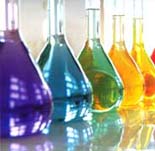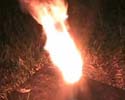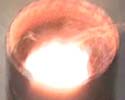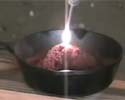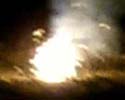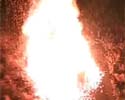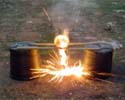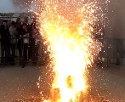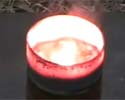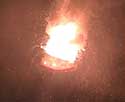Iron(III) Oxide
| Description |
Video |
Pictures |
|---|---|---|
| 100 grams of Fe2O3 Thermite reacting in a sand-filled coffee can. |
|
|
| 100 grams of Fe2O3 Thermite. Unexpectedly slow start due to poor weather conditions. | ||
| 100 grams of extra fine Fe2O3 thermite, producing white hot, liquid, Iron metal. | ||
| 500 grams of Fe2O3 thermite reacted in a heavy cast Iron skillet. A failed attempt to melt through the skillet, the skillet conducted the heat into the wooden planks supporting it, catching them on fire. Liquid Iron fused itself onto the skillet. | ||
|
50 grams of Fe2O3 thermite
react near a can of spray paint (don't try this at home)
to the sound of Tchaikovsky's 1812 Overture. |
|
|
|
2000 grams of Fe2O3 thermite, filling a large coffee can, reacts on top of a ¼ inch thick, steel, I-Beam. The resulting reaction is so intensely hot that it melts its container and the steel beam, spilling vast amounts of molten Iron and Al2O3 everywhere. |
||
|
200 grams of Fe2O3thermite
made with fine-grain (3.2 micron) aluminum powder
reacts more quickly due to the smaller particle
size. |
|
Iron(II, III) Oxide
| Description |
Video
|
Pictures |
|---|---|---|
| 100 grams of Fe3O4 thermite reacts very violently as a ball of fire and liquid Iron metal flies out of the coffee can reaction vessel. | ||
|
Three small Fe3O4 thermite
reactions in metal pots which easily melt though the
bottom, dripping molten Iron on the ground. |
||
|
300 grams of Fe3O4 thermite react very energetically, however, fails to melt through the heavy duty cast Iron skillet. |
||
|
75 grams of Fe3O4 thermite easily melt through a piece of steel and molten Iron falls into the sand below. |
||
|
200 grams of Fe3O4 thermite reacting inside galvanized steel pipe on cast Iron skillet. Due to the heat of the reaction, the Zinc coating on pipe is vaporized and converted into fluffy white puffs of Zinc Oxide . The reaction leaves the white-hot pipe thoroughly welded to the skillet and covered with ZnO. |
||
|
300 grams of Fe3O4 thermite
made with fine-grain (3.2 micron) aluminum powder
reacts more quickly due to the smaller particle
size. |
||
|
4000 grams of Fe3O4 thermite, filling a large, 10-inch diameter flower pot, reacts on top of an old hard drive. The molten metal produced by the reaction melts through the hard drive casing and platters and totally destroys the internal electronics. Sadly, no video was captured of this extremely impressive reaction. |
||
|
Video: Pictures: |
||
|
5000 grams of Fe3O4 thermite reacts at the 2010 Bay Area Maker Faire. The molten metal produced by the reaction streams out the bottom and over the sides of the large flower pot and into a pan of sand below. |
|
|
|
8200 grams of Fe3O4 thermite (+ 10 w% cryolite flux) reacts at the 2011 Bay Area Maker Faire. The molten metal pours from bottom and sides of the severely cracked flower pot and sprays into the air above. |
|
Copper(II) Oxide
| Description |
Video
|
Pictures |
|---|---|---|
| 100 gram, blindingly bright, CuO Thermite reaction glowing white hot and partially melting the coffee can. | ||
| Using extra fine Copper Oxide powder, the 100 gram thermite reaction proceeds very violently and explosively, vaporizing much of the remains, starting grass fires, and pushing observers back with a shockwave. |
|
|
| 100 grams of CuO thermite made using very fine CuO powder. Once ignited, the thermite mixture reacts extremely quickly and energetically, expelling the vast majority of the products into the air. |
|
Copper(I) Oxide
| Description |
Video
|
Pictures |
|---|---|---|
| 100 grams of Cu2O Thermite ignite by pouring Glycerin over a small amount of Potassium Permanganate. After the thermite reaction, a small blob of elemental Copper metal was found. |
|
Tin(IV) Oxide
| Description |
Video
|
Pictures |
|---|---|---|
| A 100 gram, SnO2, thermite reaction, producing a gray blob of metal containing a region of Tin metal which remained soft and molten for some time as the reaction cooled. | ||
| 100 grams of SnO2 thermite reacts producing liquid Tin metal. |
Titanium(IV)
Oxide
| Description |
Video
|
Pictures |
|---|---|---|
| This 100 gram thermite reaction proceeds very slowly, steadily consuming the thermite mixture. The reaction failed to reduce the white TiO2 to Titanium metal, but instead reduced the TiO2 to a black compound which is likely to be Ti3O5. | ||
| 100 grams of KClO3-boosted TiO2 thermite react after being ignited with Magnesium Ribbon. Thermite reaction successfully yields several grams of Titanium metal as a product. | ||
| 530 grams of KClO3-boosted
TiO2 thermite using a TiO2 : Al : KClO3
: CaF2 ratio of 100 : 75 : 50 : 40.
Reaction produces several large blobs of Titanium
metal. SEM Images EDAX Analysis – Element Composition |
||
| 2000 grams of KClO3-boosted
TiO2 thermite using a TiO2 : Al : KClO3
: CaF2 ratio of 100 : 72 : 61 : 47.
Reaction produces several large blobs of Titanium
metal. |
Manganese(IV)
Oxide
| Description |
Video
|
Pictures |
|---|---|---|
| A quick, 100 gram MnO2 thermite reaction, leaving a small, brownish-black metal chunk behind which contained very small, trace, pieces of what appeared to be Manganese metal. | ||
| 200 grams of MnO2 thermite + 10 grams of Cryolite flux. Several Manganese metal nuggets produced. |
Chromium(III)
Oxide
| Description |
Video
|
Pictures |
|---|---|---|
| A 100 gram of Cr2O3 thermite reaction. The reaction proceeds very slowly, not unlike Titanium(IV) Oxide thermite. Afterward, small chunks of shiny Chromium metal are found in the cooled remains. |
Cobalt(II) Oxide
| Description |
Video
|
Pictures |
|---|---|---|
| 25 grams of CoO thermite react while tiny, red-hot, metal fragments are thrown from the container. |
Yellow Iron Oxide
| Description |
Video
|
Pictures |
|---|---|---|
| 100 grams of Yellow Iron Oxide thermite reaction reacts surprisingly vigorously, leaving a very hot blob of glowing metal. | ||
| 400 grams of Yellow Iron Oxide thermite reacts inside nested flower pots. Liquid metal is clearly visible pouring through hole in the bottom of the pot into the sand below. |
Silicon Dioxide
| Description |
Video
|
Pictures |
|---|---|---|
| 300 gram mixture of Silicon Dioxide,
Aluminum powder, and Sulfur burns slowly with a
bright blue flame; a large lump of elemental Silicon
is produced during reaction. Reaction continues even
after camera stops filming. Out of site of the
camera, the thermite reaction melts through the side
of the steel reaction vessel. |
||
| 1000 gram mixture of Silicon Dioxide, Aluminum powder, and Sulfur burns slowly for about 2 minutes 30 seconds. |
|
Nickel(II) Oxide
| Description |
Video
|
Pictures |
|---|---|---|
| 50 grams of green Nickel Oxide thermite. The NiO thermite begins to react after a short delay after the Potassium Chlorate and sugar ignition mixture is lit. |
Vanadium(V) Oxide
| Description |
Video
|
Pictures |
|---|---|---|
| 50 grams of Vanadium Pentoxide thermite. Reaction proceeds extremely quickly after being ignited by Potassium Chlorate and sugar. | ||
| 200 grams of V2O5 thermite + 20 grams of Cryolite flux (total mixture 220 grams). The reaction proceeds quickly after ignition by Potassium Chlorate, sugar, and Magnesium Ribbon. |
Silver(I) Oxide
| Description |
Video
|
Pictures |
|---|---|---|
| Two attempts to ignite a 21
gram Ag2O thermite mixture using a
Magnesium ribbon fuse. Thermite begins to
react but quickly stops, appearing to 'blow
itself out' after area around Mg ribbon
ignites. Small round globules of Silver metal
found around areas where reaction occurred. EDAX Analysis – Element Composition |
Molybdenum(VI)
Oxide
| Description |
Video
|
Pictures |
|---|---|---|
| 17 grams of MoO3 thermite description reacts quickly in a bright flash. |
Alloy Thermite
| Description |
Video
|
Pictures |
|---|---|---|
| 200 grams of thermite made using a mixture of Fe2O3, Cu2O, and Cr2O3 thermites in a ratio of 7 : 8 : 5 by weight. As a result of the reaction, a copper-colored metal alloy was formed containing Iron, Copper, and Chromium metals in a theoretical ratio of 3 : 5 : 2 by weight. A small amount of Cryolite flux was utilized. | ||
| 200 grams of Manganese(III) Oxide thermite (placed on bottom of container) with about 125 grams of Iron(II, III) Oxide thermite on top. The Fe3O4 thermite was ignited which, in turn, ignited the Mn2O3 thermite. Excellent slag-metal separation leaving a large blob of ferromanganese alloy metal. No flux used. |
|
|
| 220 grams of thermite made with a ratio of 5 : 3 : 2 between stoichiometric mixtures of NiO, Fe3O4, and Mn2O3 thermites respectively. Additionally, 30 grams of Cryolite flux was added bringing the total mass of the mixture to 250 grams. The reaction proceeded somewhat slowly once ignited using Potassium Chlorate, sugar, and Magnesium Ribbon, but burned quite hot and left a large chunk of alloyed metal behind. |
Original pictures and videos available upon request.
Last updated:
1/1/2012


